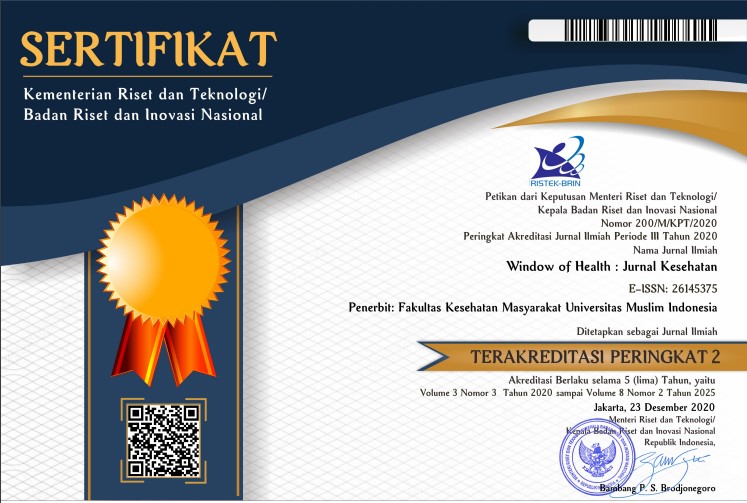Enhancing Self-Awareness to Prevent Gender-Based and Sexual Violence on Campus through Interprofessional Education Intervention
Self-Awareness to Prevent Gender-Based and Sexual Violence on Campus
Abstract
Gender-based sexual violence on campus is a serious issue and is a less serious concern. Students tend to lack an understanding of sexual issues caused by the culture on campus that disfavors the victim by the theory of power relations and a feminist perspective. Students’ knowledge and awareness of gender-based sexual violence on campuses need to be improved. This study assesses students’ self-awareness due to health promotion provided through the Interprofessional Education (IPE) approach. A quasi-experiment with a pre-post-test design was conducted to evaluate 144 students through purposive sampling. The questionnaire adapted from the Situational Self-Awareness Scale (SSAS) was utilized to collect the data. There was a significant improvement in self-awareness (p < 0.001 and t-value= 25.68) after receiving IPE among students. Providing health education with an IPE approach is an effective strategy for raising undergraduate students' awareness of gender-based sexual violence on campus. This intervention may help develop the concept of cooperation and collaboration between health professionals to prepare and create standard measures for preventing and addressing cases of gender-based sexual violence on campus.
References
Laverty C, De Vos D. Reproductive Violence as a Category of Analysis: Disentangling the Relationship between ‘the Sexual’ and ‘the Reproductive’ in Transitional Justice. International Journal of Transitional Justice 2022; 15: 616–635.
Kerr G. What Is Gender-Based Violence? In: Gender-Based Violence in Children’s Sport. London: Routledge, pp. 33–45.
Chivers-Wilson KA. Sexual assault and posttraumatic stress disorder: a review of the biological, psychological and sociological factors and treatments. Mcgill J Med 2006; 9: 111–118.
Fedina L, Holmes JL, Backes BL. Campus Sexual Assault: A Systematic Review of Prevalence Research From 2000 to 2015. Trauma, Violence, & Abuse 2018; 19: 76–93.
Tempo. Kekerasan Seksual di Kampus Menjamur, Regulasi Dinilai Tak Cukup. Tempo, http://www.tempo.co/dw/6038/kekerasan-seksual-di-kampus-menjamur-regulasi-dinilai-tak-cukup (2021, accessed 24 April 2024).
BBC News. Mengapa ‘tanpa persetujuan korban’ dimaknai pelegalan kebebasan seks’? BBC News Indonesia, 2021, https://www.bbc.com/indonesia/indonesia-59265939 (2021, accessed 24 April 2024).
Bonar EE, DeGue S, Abbey A, et al. Prevention of sexual violence among college students: Current challenges and future directions. Journal of American College Health 2022; 70: 575–588.
Mabachi NM, Quiason M, Doan AE, et al. Developing an Effective Campus Sexual Assault Prevention Task Force: Lessons Learned From Multiple Midwestern Universities. Health Education and Behavior; 47. Epub ahead of print 2020. DOI: 10.1177/1090198120909809.
Denford S, Abraham C, Campbell R, et al. A comprehensive review of reviews of school-based interventions to improve sexual-health. Health Psychology Review 2017; 11: 33–52.
Lindberg LD, Maddow-Zimet I, Boonstra H. Changes in Adolescents’ Receipt of Sex Education, 2006–2013. Journal of Adolescent Health 2016; 58: 621–627.
Rusyidi B, Bintari A, Wibowo H. Pengalaman Dan Pengetahuan Tentang Pelecehan Seksual: Studi Awal Di Kalangan Mahasiswa Perguruan Tinggi (Experience And Knowledge On Sexual Harassment: A Preliminary Study Among Indonesian University Students). Share : Social Work Journal; 9. Epub ahead of print 2019. DOI: 10.24198/share.v9i1.21685.
Decker MR, Wood SN, Ndinda E, et al. Sexual violence among adolescent girls and young women in Malawi: A cluster-randomized controlled implementation trial of empowerment self-defense training. BMC Public Health; 18. Epub ahead of print 2018. DOI: 10.1186/s12889-018-6220-0.
Fitriana RN, Suryawati C, Zubaidah Z. Effect Of Peer Education Model On Knowledge And Self-Efficacy Of Children In The Prevention Of Physical Sexual Violence. Belitung Nursing Journal; 4. Epub ahead of print 2018. DOI: 10.33546/bnj.341.
Nikmatullah. Demi Nama Baik Kampus VS Perlindungan Korban: Kasus Kekerasan Seksual di Kampus. Qawwam: Journal for Gender Mainstreaming; 14.
Garcia L, Fields J. Renewed commitments in a time of vigilance: sexuality education in the USA. Sex Education 2017; 17: 471–481.
Lameiras-Fernández M, Martínez-Román R, Carrera-Fernández MV, et al. Sex Education in the Spotlight: What Is Working? Systematic Review. IJERPH 2021; 18: 2555.
Van Diggele C, Roberts C, Burgess A, et al. Interprofessional education: tips for design and implementation. BMC Medical Education; 20. Epub ahead of print 2020. DOI: 10.1186/s12909-020-02286-z.
Dyess AL, Brown JS, Brown ND, et al. Impact of interprofessional education on students of the health professions: a systematic review. J Educ Eval Health Prof 2019; 16: 33.
Lapkin S, Levett-Jones T, Gilligan C. A systematic review of the effectiveness of interprofessional education in health professional programs. Nurse education today 2013; 33: 90–102.
Kelly PL, Heyman JC, Tice-Brown D, et al. Interprofessional practice: Social work students’ perspectives on collaboration. Social Work in Health Care; 59. Epub ahead of print 2020. DOI: 10.1080/00981389.2020.1719565.
Govern JM, Marsch LA. Development and validation of the situational self-awareness scale. Consciousness and Cognition 2001; 10: 366–378.
Chandra-Mouli V, Svanemyr J, Amin A, et al. Twenty years after international conference on population and development: Where are we with adolescent sexual and reproductive health and rights? Journal of Adolescent Health; 56. Epub ahead of print 2015. DOI: 10.1016/j.jadohealth.2014.09.015.
Orbayinah S, Utami LP. Impact of Interprofessional Education on Collaboration Attitudes Among The Student of Medical Faculty and Health Sciences Universitas Muhammadiyah Yogyakarta. Journal of Health, Medicine, and Nursing 2015; 17: 97–100.
Utami NAT, Afwa U. Peningkatan Program Pendewasaan Usia Perkawinan (PUP) melalui Pusat Informasi Konseling Remaja (PIK-R) di Kabupaten Purbalingga. Prosiding; 9.
Coulter RWS, Rankin SR. College Sexual Assault and Campus Climate for Sexual- and Gender-Minority Undergraduate Students. J Interpers Violence 2020; 35: 1351–1366.
Green EC, Murphy EM, Gryboski K. The Health Belief Model. In: Paul RH, Salminen LE, Heaps J, et al. (eds) The Wiley Encyclopedia of Health Psychology. Wiley, pp. 211–214.
Allison A, Weerahandi A, Johnson T, et al. A Scoping Review on the Use of Experiential Learning in Professional Education on Intimate Partner Violence. J Fam Viol. Epub ahead of print 4 May 2023. DOI: 10.1007/s10896-023-00552-4.
Copyright (c) 2025 Noer Saudah, Chasiru Zainal Abidin, Indah Lestari, Esti Andarini, A'im Matun Nadhiroh; Heni Frilasari; Yudisa Diaz Lutfi Sandi

This work is licensed under a Creative Commons Attribution-NonCommercial-ShareAlike 4.0 International License.








